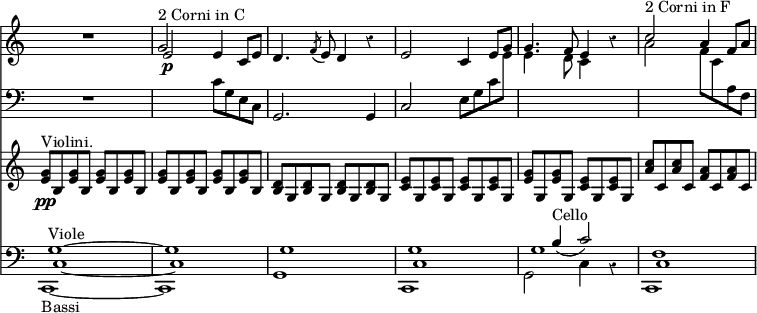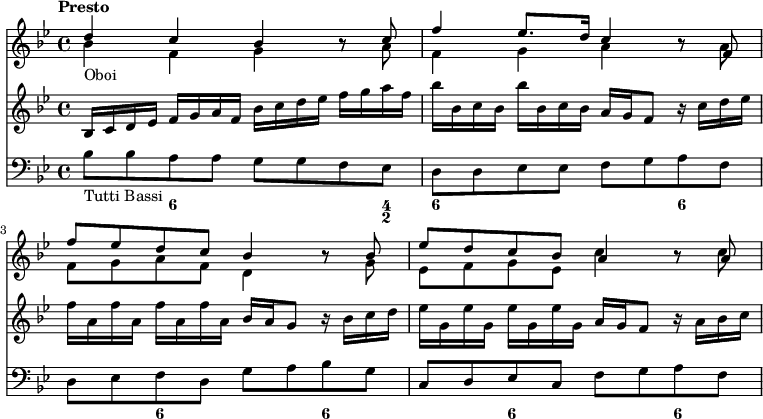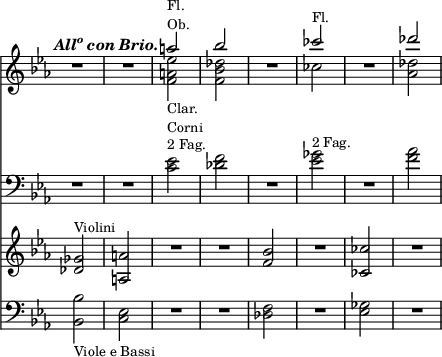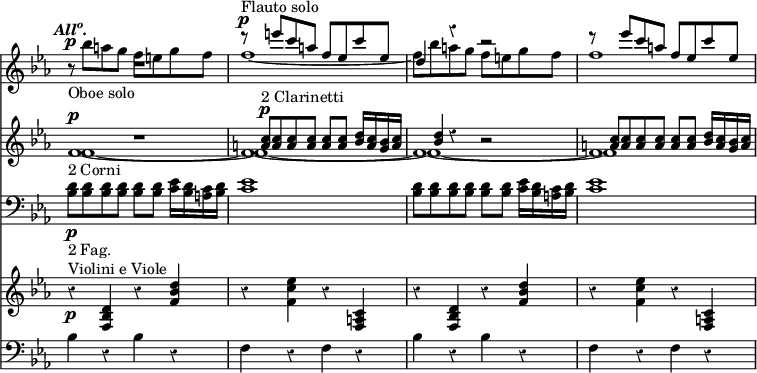A Dictionary of Music and Musicians/Orchestration
ORCHESTRATION (Instrumentation). The art of adapting musical ideas to the varied capabilities of Stringed, Wind, Keyed, and other Instruments. [See Orchestra.]
It is scarcely possible to over-estimate the influence exercised by this branch of technical Science upon the advancement of modern Music. The modifications through which it has passed are as countless as the styles to which it has given rise: yet its history, as recorded in the Scores of the Great Masters, proves the principles upon which it is based to be as unalterable as their outward manifestation is, and always must be, variable, and subject to perpetual progress. Unaccompanied Vocal Music, however marked may be the differences existing between its individual Schools, must, perforce, remain permanently subject to the laws imposed upon it by the character of the human Voice. For Instrumental Music no permanent legislation is possible. Eveiy new Instrument introduced into the Orchestra influences, more or less, every one of its companions. Every improvement in the form, compass, quality of tone, or executive powers of the Instruments already in use, suggests new ideas to the Composer, and results in an endless variety of new combinations. To the number of such improvements there is no limit. Stringed Instruments, it is true, change but little, except in the manner of their handling. The Violin of to-day is the Violin of two centuries ago. Not so the Wind Instruments. The Trumpet now in common use differs almost as much from that with which Handel and Bach were familiar as it does from the Organ Stop to which it lends its name. The Flute, as known to Haydn and Mozart, could scarcely hold its own, except in the upper octave, against half-a-dozen Violins: the tone of its modern successor is as powerful as that of the Clarinet, and brilliant enough to make itself heard with ease through the full Orchestra; its powers of execution are almost unlimited; and, better still, it can be played perfectly in tune—which the old Flute could not. Improvements scarcely less important have been made in the Horn, the Clarinet, and the Oboe. The Trombone has suffered comparatively little change; and the Bassoon retains, substantially unaltered, the form it bore when Handel wrote for it: but these alone, among Wind Instruments, have escaped a sweeping metamorphosis since the beginning of the present century; and, remembering this, we can scarcely feel surprised that the orchestration of the 'Occasional Overture' should bear but little outward resemblance to that of the Overture to 'Tannhäuser.' Yet the bond of union subsisting even between such extremes as these is much closer than might, at first sight, be supposed. The principle is in all cases the same. The best Composers of every epoch have aimed at the same general characteristics; and experience has proved that, where these are present, no combinations can be condemned as wholly ineffective, whether they bear the stamp of true genius or not.
The most prominent characteristics of good Instrumentation are (I.) Solidity of Structure, (II.) Breadth of Tone, (III.) Boldness of Contrast, and (IV.) Variety of Colouring. We will endeavour to illustrate each of these necessary qualities by examples selected from the Scores of a few Great Masters of different periods.
I. Solidity of structure can only be obtained by careful management of the Stringed Instruments. If the part allotted to these be not complete in itself, it can never be completed by Wind Instruments. Whether written in five, four, three, or two parts, or even in unison, it must sound well, alone. This principle was thoroughly understood even as early as the close of the 16th century, when the originators of the newly-invented instrumental Schools bestowed as much care upon their Viols as their immediate predecessors had devoted to their vocal parts. For instance, the following air, from 'Le Balet comique de la Royne'—a piece written in 1581 and alluded to in the preceding article—is so arranged as to be equally complete, whether played by Viols alone or with each separate part aided by a ripieno Wind Instrument.
Le Son de la Clochette, auquel Circé sortit de son Jardin.

Handel constructed many of his finest Overtures upon this principle; and, in common with Sebastian Bach and other great Composers of the 18th century, delighted in its fine, bold, masculine effect. Later writers improved upon it by embellishing the stringed foundation with independent passages for Wind Instruments. Thus Mozart, in his Overture to 'Figaro,' first gives the well-known subject to the Violins and Basses in unison, and then repeats it, note for note, with the addition of a sustained passage for the Flute and Oboe, which brings it out in quite a new and unexpected light—

Sometimes we find this order reversed; the subject being given to the Wind, and the accompaniment to the Stringed Instruments; as in the opening movement of Weber's Overture to 'Der Freischütz'—

In either case, the successful effect of the passage depends entirely upon the completeness of the stringed skeleton. A weak point in this—whether the principal subject be assigned to it or not—renders it wholly unfit to support the harmony of the Wind Instruments, and deprives the general structure of that firmness which it is one of the chief objects of the great Master to secure.
II. Breadth of tone is dependent upon several conditions; not the least important of which is the necessity for writing for every instrument with a due regard to its individual peculiarities. This premised, there is little fear of thinness, when the stringed parts are well arranged, and strengthened, where necessary, by Wind Instruments, which may either be played in unison with them—as in the Overture to 'Jephtha,' where Handel has reinforced the Violins by Oboes, and the Basses by Bassoons—or so disposed as to enrich the harmony in any other way best suited to the style of particular passages—as in that to 'Acis and Galatea,' in which the Oboes are used for filling in the harmonies indicated by the Figured Bass, while a brilliant two-part counterpoint, so perfect in itself that it scarcely seems to need anything to add to its completeness, is played by the Violins and Basses, the latter, as indicated by the expression Tutti Bassi, being strengthened by the Bassoons—

Among more modern writers, Beethoven stands pre-eminent for richness of tone, which he never fails to attain, either by careful distribution of his harmony among the instruments he employs, or in some other way suggested by his ever-ready invention. In the following passage, from the Adagio of the Fourth Symphony (in B♭), this richness is secured by the perfect proportion established between the tone of the Stringed and Wind Instruments, which afford each other the exact amount of support needed for the completion of the general effect—
![<< \new Staff { \override Score.TimeSignature #'stencil = ##f \time 3/4 \key ees \major \tempo \markup { \italic Adagio. } << \new Voice \relative e''' { \stemUp ees4^"Fl." d c | bes4. aes8 g aes16. f32 | ees4 d8 ees f <g g,>16 <a a,> | <a ees>4^( <bes d,>) }
\new Voice \relative b' { \stemDown s2. s r8 bes_"Oboi" }
\new Voice \relative g' { \stemDown <g ees'>4_"2 Clar." <bes d> <aes c> | <bes d,>4. <f aes>8 <ees g> <f aes>16. <f c>32 | <ees bes>4 <bes' aes d aes>8 <bes g ees g,> <bes f bes,> <ees ees,> | <ees a c>4 <d bes'> } >> }
\new Staff { \clef bass \key ees \major << \new Voice \relative e { \stemDown <ees g>4^\p_"2 Fag." <g bes> <aes c> | <f aes>4. q8 <ees g> aes, | bes2 ~ bes8 bes | bes2 }
\new Voice \relative c' { \stemUp s2. s2 s8 c16. aes32 | g4 f8 ees d c16 f | f4( bes) } >> }
\new Staff { \key ees \major \relative e' { <ees ees'>16\p^"Violini"[ r32 <g bes> <bes ees>16 q] r r32 <g bes> <bes d>16 q r r32 <aes ees> <aes c>16 q | r r32 <f d> <f bes>16 q r r32 <f bes,> <f a>16 q r r32 <g bes,> <c, aes>16 <c f> | r r32 <bes g> <bes ees>16 q r r32 <bes aes> <g ees'>16 q r r32 <bes f'> <ees g>16 <ees a> | r r32 <ees c> <ees a>16 q r r32 <bes d> <d bes'>16 q } }
\new Staff { \clef bass \key ees \major << \new Voice \relative e { \stemUp <ees ees'>2.^"2 Corni" <ees bes'>2 ~ q8 <ees ees'> <bes bes'>2 ~ q8 q | q2 }
\new Voice \relative e { \stemDown <ees ees,>8_"Viole e Bassi" r q^\markup { \italic "pizz." } q q q | q q q q q <aes aes, aes,> | <bes bes, bes,> q q q q q | q[ q q q] } >> } >>](http://upload.wikimedia.org/score/a/c/acwzy4bbq5kk1uqznfgpeoahlvmgaej/acwzy4bb.png)
The fulness of the next example, from Mendelssohn's Hebrides Overture, is chiefly due to the sustained notes played by the Horns, on the cessation of which the weak point which would otherwise have marred the effect of the passage is guarded by the entrance of the Violins and Double-basses—

Other composers have attained similar results in innumerable different ways: but it will generally be found that the most satisfactory passages are those which exhibit a judicious disposition of the harmony, a just balance between the Stringed and Wind Instruments, and a perfect adaptation of the parts to the Instruments for which they are written.
III. Boldness of contrast is produced by so grouping together the various instruments employed as to take the greatest possible advantage of their difference of timbre. We have already shown, in the preceding article, that the Instrumental Band, as now constituted, naturally divides itself into certain sections, as distinct from each other as the Manuals of an Organ. Concerning the first and most important of these—the 'Stringed Band'—enough has already been said. The second sometimes called the 'Wood Wind'—is led by the Flutes, and completed by Reed Instruments, such as the Oboe, the Clarinet, and the Bassoon. The third—the 'Brass Band'—is subdivided into two distinct families; one formed by the Horns and Trumpets, to which latter the drums supply the natural bass; the other comprising the three Trombones, and, in the noisy Orchestras of the present day, the Ophicleide and Euphonium. The principle of subdivision is, indeed, frequently extended to all the great sections of the Orchestra. For instance, the Flutes and Oboes are constantly formed into a little independent Band, and contrasted with the Clarinets and Bassoons. Handel even divides the Stringed Band, and produces fine effects of contrast by so doing. In a large proportion of his best and most celebrated Songs, the Voice is accompanied by a 'Thoroughbass' alone: that is to say, by a part for the Violoncello and Double Bass, with figures placed below the notes to indicate the Chords intended to be filled in on the Organ or Harpsichord. The Symphonies are played by the Violins, in unison, with a similar 'Thoroughbass' accompaniment; and the entrance of these instruments, between the vocal passages, is marked by a contrast as striking as it is agreeable. In the following example, from the 'Messiah,' the Chords indicated by the figures—which no one who claims to be considered a 'Musician' ought to find any difficulty in filling in at sight—are printed in small notes.

In some of his Songs, Handel has enlarged upon this method; as in 'Lascia ch'io pianga,' from 'Rinaldo,' the first part of which is accompanied by the full Stringed Band, and the second by a 'Thoroughbass' only, the Violins and Viola reappearing at the Da capo. It is impossible to believe that the great Composers of the last century, with Handel and Bach at their head, adopted this style of accompaniment without having duly considered its effect: and any attempt to heighten that effect by 'additional accompaniments'—by whomsoever designed—shews as little reverence for Art as would be evinced by a desire to cover the Madonna di San Sisto with 'additional glazings.' The Songs are perfect as they stand: and the contrast they display is as marked in its degree as that in the celebrated passage from Beethoven's Fifth Symphony (in C minor), in which the Stringed Instruments and Wood Wind are made to answer each other in alternate Chords—

This last expedient is by no means uncommon in modern music; and has been most successfully used by Mendelssohn in his Overture to 'A Midsummer Night's Dream,' where a few sustained notes on the Wind Instruments are contrasted with the rapid passage for four Violins with excellent effect. The Trio, for Brass Instruments, in the Minuet of Sterndale Bennett's Symphony in G minor, is another striking instance of fine and quite unexpected contrast: and cases abound in which Composers of Instrumental Music have treated the several sections of the Orchestra very much in the way in which vocal writers treat alternate Choirs, producing thereby innumerable beautiful effects of bold relief, and strongly contrasted tone.
IV. Variety of colouring results from the judicious blending together of the several elements which we have just considered as opposed to each other in more or less violent contrast. In the Instrumentation of the Great Masters this quality is always conspicuous: in that of inferior writers never. Its presence may, indeed, be regarded as one of the surest possible indications of true genius, which never fails to attain it in the face of any amount of difficulty.
In the 18th century Handel wrought marvels with the slender means at his command: with Trumpets and Oboes in the opening movements of the 'Occasional Overture' and the 'Dettingen Te Deum'; with Oboes and Bassoons in 'The Lord is a man of War'; with Flutes and Horns in 'Surge procelle, ancora'; with a somewhat larger number of Wind Instruments in 'Wise men flattering'; but often, as in 'Angels ever bright and fair,' with the Stringed Band alone, and always with infinite variety of tone and expression. Sebastian Bach anticipated, in like manner, many of our most highly-prized modern effects, as in the delicious combination of Horn and Bassoons in the 'Quoniam tu solus' of his Mass in B minor—

As new Wind Instruments were invented, or old ones improved, the power of producing variety of colouring became, of course, immeasurably increased. Haydn took signal advantage of this circumstance in the 'Creation' and the 'Seasons': but Mozart's delightful system of Instrumentation surpasses, in beauty, that of all his contemporaries. His alternations of light and shade are endless. Every new phrase introduces us to a new effect; and every Instrument in the Orchestra is constantly turned to account, always with due regard to its character and capabilities, and always with a happy result. In the following passage from the Overture to 'Die Zauberflöte,' for instance, the whole strength of the Wood Wind is so employed as to shew off every Instrument at its best, while the stringed accompaniment gives point to the idea, and the sustained notes on the Horns add just support enough to perfect its beauty—

It would be incorrect to say that Beethoven was a greater master of this peculiar phase of Instrumentation than Mozart; though in this, as in everything else, he certainly repeated his own ideas less frequently than any writer that ever lived. The wealth of invention exhibited in the orchestral effects of this Composer—even in those of his works which were produced after his unhappy deafness had increased to such an extent that he could not possibly have heard any one of them—is boundless. In every composition we find a hundred combinations; all perfectly distinct from one another, yet all tending, in spite of their infinite variety, to the same harmonious result; and all wrought out, with indefatigable care, in places which many less conscientious authors would have passed over as of comparatively little importance such, for instance, as the two or three concluding bars of the slow movement of the Pastoral Symphony (No 6, in F)—

This minute attention to detail is observable throughout the entire series of Beethoven's orchestral works: and we may well believe that it stimulated in no small degree the emulation of his contemporaries; for the age in which he lived produced more than one instrumentalist of the highest order. Schubert, we need hardly say, is a host in himself. Weber's mastery over the Orchestra is perfect, and adds not a little to the charm of his delightful compositions. The dreamy opening of his Overture to 'Oberon,' with its three sweet notes for the Horn, followed by one of the most faërylike passages for the Flutes and Clarinets that ever was imagined; the lovely melody allotted to the Horns in the Overture to 'Der Freischütz,' and the eldritch sounds which succeed it; above all, the mysterious Largo, for four Violini, con sordini, which so strangely interrupts the Allegro of the overture to 'Euryanthe,' and the gloomy tremoli for the Viola which add so much to its weird effect; these, and a hundred similar passages, evince a purity of taste and an originality of conception which have rarely, if ever, been exceeded by the greatest Masters. Mendelssohn exhibits scarcely less richness of invention in his Symphonies, his Concertos, and, especially, in his charming Concert Overtures to 'Die Schöne Melusine' and 'A Midsummer Night's Dream.' In freshness of colouring, and inexhaustible fertility of resource, Spohr's great Symphony, 'Die Weihe der Töne' has never been surpassed. Berlioz—whose 'Traité d'Instrumentation' no young composer should neglect to read—studied the subject deeply, and with extraordinary success. And, undoubtedly, the strongest of Richard Wagner's strong points is that intimate acquaintance with the Orchestra in all its phases, which, guided by his keen perception of effect, enables him to weave its elements into any new combinations best suited to his purpose. He it was who first conceived, among other daring and beautiful innovations, the idea of using the high harmonic sounds of the Violin, in unison with Flutes and other Wind Instruments. The Prelude to 'Lohengrin' depends, almost entirely, for its enchanting effect, upon four solo Violins and three Flutes, used in a way before unknown, and crowned, it is needless to say, with triumphant success—

[ W. S. R. ]